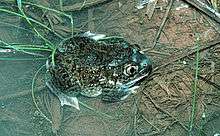Plains spadefoot toad
| Plains spadefoot toad | |
|---|---|
 | |
| Scientific classification | |
| Kingdom: | Animalia |
| Phylum: | Chordata |
| Class: | Amphibia |
| Order: | Anura |
| Suborder: | Mesobatrachia |
| Family: | Scaphiopodidae |
| Genus: | Spea |
| Species: | S. bombifrons |
| Binomial name | |
| Spea bombifrons (Cope, 1863) | |
| Synonyms | |
The plains spadefoot toad (Spea bombifrons) is a species of American spadefoot toad which ranges from southwestern Canada, throughout the Great Plains of the western United States, and into northern Mexico. Like other species of spadefoot toads, they get their name from a spade-like projections on their hind legs which allow them to dig into sandy soils.
Description
The plains spadefoot toad generally grows from 1.5 to 2.5 inches in length, has a round body, with relatively short legs. These toads are usually a tannish to dark brownish color with visible orange spots. They are one of the easiest toads to recognize in their region because of their appearance looking more like a frog. Sometimes, they have light striping on their backs.
Behavior
Plains spadefoot toads are nocturnal and secretive. They spend most of the dryer seasons buried in the soil in estivation, typically only emerging during spring and fall rains. Breeding takes place in temporary pools of water left by rainfall, which requires the tadpoles to metamorphose quickly, before the water dries up. Eggs, laid in clutches numbering from 10-250, often hatch within 48 hours of being laid, and the larvae can change into tadpoles in as little as two weeks. The tadpoles exhibit phenotypic plasticity, with some changing from an omnivorous morphology into a cannibalistic carnivorous morph with oversized jaw muscles and pronged beaks. In some cases, female spadefoot toads will choose to mate with Spea multiplicata rather than with males of their own species, if the resulting hybrid tadpole would have higher chances of survival.[1] Character displacement has also been examined in ponds where Spea bombifrons and Spea multiplicata occur together. Reproductive and ecological competition between the two species likely causes selection for smaller and less reproductively successful individuals of Spea multiplicata. [2]
References
- ↑ Pfennig, Karin S. (2007-11-09). "Facultative Mate Choice Drives Adaptive Hybridization". Science. 318 (5852): 965–967. doi:10.1126/science.1146035. Retrieved 2011-09-12.
- ↑ Pfennig, Karin S; David W Pfennig (October 2005). "Character displacement as the "best of a bad situation": fitness trade-offs resulting from selection to minimize resource and mate competition". Evolution; International Journal of Organic Evolution. 59 (10): 2200–2208. doi:10.1111/j.0014-3820.2005.tb00928.x. ISSN 0014-3820. PMID 16405163.
